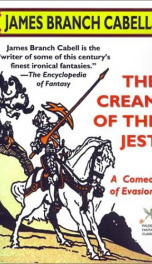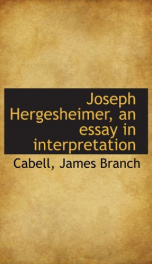Cabell James Branch
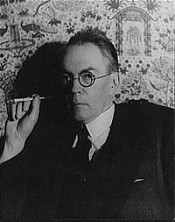
James Branch Cabell, pronounced /ˈkæbəl/ (April 14, 1879 – May 5, 1958) was an American author of fantasy fiction and belles lettres. Cabell was well regarded by his contemporaries, including H. L. Mencken and Sinclair Lewis. His works were considered escapist and fit well in the culture of the 1920s, when his works were most popular. For Cabell, veracity was "the one unpardonable sin, not merely against art, but against human welfare."[1] Interest in Cabell declined in the 1930s, a decline that has been attributed in part to his failure to move out of his fantasy niche. Alfred Kazin said that "Cabell and Hitler did not inhabit the same universe".[1] Although escapist, Cabell's works are ironic and satirical. H. L. Mencken disputes Cabell's claim to romanticism, characterized him as "really the most aciduous of all the anti-romantics. His gaudy heroes... chase dragons precisely as stockbrockers play golf." Cabell saw art as an escape from life, but once the artist creates his ideal world, he finds that it is made up of the same elements that make the real one.[1] Cabell was born into an affluent and well-connected Virginian family, and lived most of his life in Richmond. His father, Robert Gamble Cabell II (1847–1922), was a physician, and his mother, Anne Harris (1859–1915), was the daughter of Col. and Mrs James R. Branch. Cabell's paternal great-grandfather, William H. Cabell, was governor of Virginia from 1805 to 1808. Cabell County in West Virginia is named after a branch of his family. James was the oldest of three boys — his brothers were Robert Gamble Cabell III (1881–1968) and John Lottier Cabell (1883–1946). His parents separated and were later divorced in 1907.[2] Although Cabell's surname is often mispronounced "Ka-BELL", he himself pronounced it "CAB-ble". To remind an editor of the correct pronunciation, Cabell composed this rhyme: "Tell the rabble my name is Cabell." Cabell matriculated to the College of William and Mary in 1894 at the age of fifteen and graduated in 1898. While an undergraduate, Cabell taught French and Greek at the College. According to his close friend and fellow author Ellen Glasgow, Cabell developed a friendship with a professor at the college which was considered by some to be "too intimate" and as a result Cabell was dismissed, although he was subsequently readmitted and finished his degree.[3] Following his graduation, he worked from 1898 to 1900 as a newspaper reporter in New York City, but returned to Richmond in 1901, where he worked several months on the staff of the Richmond News.[2] 1901 was an eventful year for Cabell: his first stories were accepted for publication, and he was suspected of the murder of John Scott, a wealthy Richmonder. It was rumored that Scott was "involved" with Cabell's mother. Cabell's supposed involvement in the Scott murder and his college "scandal" were both mentioned in Ellen Glasgow's posthumously published (1954) autobiography The Woman Within.[3] In 1902, seven of his first stories appeared in national magazines and over the next decade he wrote many short stories and articles, contributing to nationally published magazines including Harper's Monthly Magazine and the Saturday Evening Post, as well as carrying out extensive research on his family's genealogy.[2] Between 1911 and 1913, he was employed by his uncle in the office of the Branch coalmines in West Virginia. On November 8, 1913, he married Priscilla Bradley Shepherd, a widow with five children by her previous marriage.[2] In 1915 a son, Ballard Hartwell Cabell, was born. Priscilla died in March 1949; Cabell remarried in June 1950 to Margaret Waller Freeman. During his life, Cabell published fifty-two books, including novels, genealogies, collections of short stories, poetry, and miscellanea. He was elected to the American Academy of Arts and Sciences in 1937. Today, the modern languages house and an endowed law professorship at the College of William and Mary are named in his honor. Cabell died of a cerebral hemorrhage in 1958. He is buried in Hollywood Cemetery in Richmond. In 1970, Virginia Commonwealth University, also located in Richmond, named its main campus library "James Branch Cabell Library" in his honor. In the 1970s Cabell's library and personal papers were moved from his home on Monument Avenue to the James Branch Cabell Library. Consisting of some 3,000 volumes, the collection includes manuscripts, notebooks and scrapbooks, periodicals in which Cabell's essays, reviews and fiction were published, his correspondence with noted writers including H. L. Mencken, Ellen Glasgow, Sinclair Lewis and Theodore Dreiser, correspondence with family, friends, editors and publishers, newspaper clippings, photographs, periodicals, criticisms, printed material, publishers' agreements and statements of sales.[4] The VCU undergraduate literary journal at the university is named Poictesme after the fictional province in his novel Jurgen. Cabell's eighth (and best-known) book, Jurgen, A Comedy of Justice (1919), was the subject of a celebrated obscenity case shortly after its publication. The eponymous hero, who considers himself a "monstrous clever fellow", embarks on a journey through ever more fantastic realms, even to hell and heaven. Everywhere he goes, he winds up seducing the local women, even the Devil's wife. The novel was denounced by the New York Society for the Suppression of Vice; they attempted to bring a prosecution for obscenity. The case went on for two years before Cabell and his publisher, Robert M. McBride, won: the "indecencies" were double entendres that also had a perfectly decent interpretation, though it appeared that what had actually offended the prosecution most was a joke about papal infallibility. The presiding judge, Charles C. Nott, wrote in his decision that "...the most that can be said against the book is that certain passages therein may be considered suggestive in a veiled and subtle way of immorality, but such suggestions are delicately conveyed" and that because of Cabell's writing style "...it is doubtful if the book could be read or understood at all by more than a very limited number of readers."[2] Cabell took an author's revenge: the revised edition of 1926 included a previously "lost" passage in which the hero is placed on trial by the Philistines, with a large dung-beetle as the chief prosecutor. He also wrote a short book, Taboo, in which he thanks John H. Sumner and the Society for Suppression of Vice for generating the publicity that gave his career a boost. Due to the notoriety of the suppression of Jurgen, Cabell became a figure of international fame. In the early 1920s he became the leader of a group of writers known as "The James Branch Cabell School", which included such figures as H. L. Mencken, Carl Van Vechten and Elinor Wylie. A great deal of Cabell's works has focused on The Biography of Manuel, the story of Dom Manuel and his descendants through many generations. The biography includes a total of twenty five works that were written over a 23 year period. Cabell stated that he considered the Biography to be a single work, and supervised its publication in a single uniform edition of 18 volumes, known as the Storisende Edition, published from 1927 to 1930. A number of the volumes of the Biography were also published in editions illustrated by Frank C. Papé between 1921 and 1926. The themes and characters from Jurgen make appearances in many works included in the Biography. Figures of Earth tells the story of Manuel the swineherd, a scoundrel who rises to conquer a realm by playing on others' expectations – his motto Mundus Vult Decipi, meaning "the world wishes to be deceived". The Silver Stallion is a loose sequel to Figures of Earth that deals with the creation of the legend of Manuel the Redeemer, in which Manuel is pictured as an infallible hero, an example to which all others should aspire; the story describes the story of Manuel's former knights, who remember how things really were and take different approaches to reconciling the mythology with the actuality of Manuel.[1] Many of these books take place in the fictional country eventually ruled by Manuel, known as "Poictesme", (pronounced "pwa-tem"). It was the author's intention to situate Poictesme roughly in the south of France. The name suggests the two real French cities of Poitiers (medieval Poictiers) and Angoulême (medieval Angoulesme). Several others take place in the fictional town of Lichfield, Virginia. After concluding the Biography in 1932, Cabell shortened his pen name to Branch Cabell. The "truncated" name was used for all his new, "post-Biography" publications until the printing of There Were Two Pirates (1946). Though Cabell is best known as a fantasist, the plots and characters of his first few novels, The Eagle's Shadow (1904), The Cords of Vanity (1909), and The Rivet in Grandfather's Neck (1915), (later all adapted for inclusion into the Biography) do not wander out of the everyday society of Virginia's beleaguered gentry. But Cabell's signature droll style is clearly in evidence, and in later printings each book would bear a characteristically Cabellian subtitle: A Comedy of Purse-Strings, A Comedy of Shirking, and A Comedy of Limitations, respectively. His later novel, The First Gentleman of America: A Comedy of Conquest (1942), retells the strange career of an American Indian from the shores of the Potomac who sailed away with Spanish explorers, later to return, be made chief of his tribe, and kill all the Spaniards in the new Virginia settlement. Cabell delivered a more concise, historical treatment of the novel's events in The First Virginian, part one of his 1947 work of non-fiction, Let Me Lie, a book on the history of Virginia. Other works include: Cabell also wrote a number of autobiographical and genealogical works. Cabell's work was thought of very highly by a number of his peers, including Mark Twain, Sinclair Lewis, H. L. Mencken, Joseph Hergesheimer, and Jack Woodford. When Twain died he was reading Cabell's Chivalry. Although now largely forgotten by the general public, his work was remarkably influential on later authors of fantastic fiction. James Blish was a fan of Cabell's works, and for a time edited Kalki, the journal of the Cabell Society. Robert A. Heinlein was greatly inspired by Cabell's boldness, and originally described his famous book Stranger in a Strange Land as "a Cabellesque satire". A later work, Job: A Comedy of Justice (with the title derived from Jurgen, A Comedy of Justice), features Jurgen, an appearance of the Slavic god Koschei.[5] Fritz Leiber's Swords of Lankhmar was also influenced by Jurgen. Jack Vance's Dying Earth books show considerable stylistic resemblances to Cabell; Cugel the Clever in those books bears a strong resemblance, not least in his opinion of himself, to Jurgen. Cabell was also a major influence on Neil Gaiman,[6] acknowledged as such in the rear of Gaiman's novels Stardust and American Gods. This thematic and stylistic influence is highly evident in the multi-layered pantheons of Gaiman's most famous work, The Sandman, which have many parallels in Cabell's work, particularly Jurgen.
do you like this author?
What readers are saying
What do you think? Write your own comment on this book!
write a commentWhat readers are saying
What do you think? Write your own comment on this author!
write a commentBook list

TabooA Legend Retold from the Dirghic of Sævius Nicanor,withProlegomena,Notes,and a Preliminary Memoir
Series:
Unknown
Year:
Unknown
Raiting:
4.5/5
Show more
add to favoritesadd In favorites

The Rivet in Grandfather's NeckA Comedy of Limitations
Series:
Unknown
Year:
Unknown
Raiting:
5/5
Show more
add to favoritesadd In favorites
Book list

TabooA Legend Retold from the Dirghic of Sævius Nicanor,withProlegomena,Notes,and a Preliminary Memoir
Series:
Unknown
Year:
Unknown
Raiting:
4.5/5
Show more
add to favoritesadd In favorites

The Rivet in Grandfather's NeckA Comedy of Limitations
Series:
Unknown
Year:
Unknown
Raiting:
5/5
Show more
add to favoritesadd In favorites

branchiana being a partial account of the branch family in virginia
Series:
Unknown
Year:
Unknown
Raiting:
4.5/5
Reprint of a classic work originally published in 1907.
Show more
add to favoritesadd In favorites
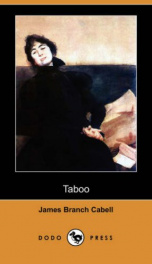
Taboo
Series:
Unknown
Year:
Unknown
Raiting:
3.5/5
James Branch Cabell (1879-1958) was an American author of fantasy fiction and belles lettres. He worked from 1898 to 1900 as a newpaper reporter in New York City, but returned to Richmond in 1901, where he worked several months on the staff of the Richmond News. In 1902, seven of his first stories appeared in national magazines and over the next decade he wrote many short stories and articles, contributing to nationally published magazines including Harper's Monthly Magazine and the Saturday Evening Post, as well as carrying out extensive research on his family's genealogy. In the early 1920s he became the leader of a group of writers known as "The James Branch Cabell School", which included such figures as H. L. Mencken, Carl Van Vechten and Elinor Wylie. He was elected to the American Academy of Arts and Sciences in 1937. Amongst his best known works are: The Eagle's Shadow (1904), The Cords of Vanity: A Comedy of Shirking (1909), and The Rivet in Grandfather's Neck: A Comedy of Limitations (1915).
Show more
add to favoritesadd In favorites
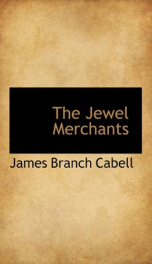
The Jewel Merchants
Series:
Unknown
Year:
Unknown
Raiting:
3.5/5
GUIDO Am I to be welcomed merely for the sake of my gems? You were more gracious, you were more beautifully like your lovely name, on the fortunate day that I first encountered you ... only six weeks ago, and only yonder, where the path crosses the highway. But now that I esteem myself your friend, you greet me like a stranger. You do not even invite me into your garden. I much prefer the manner in which you told me the way to the inn when I was an unknown passer-by. And yet your pennant promised greeting. --This text refers to an alternate Paperback edition.
Show more
add to favoritesadd In favorites
What readers are saying
What do you think? Write your own comment on this author!
write a commentGenre
- Books
- Books / Electronic books
- Literature & Fiction / Contemporary
- Outdoors & Nature / Ecology
- Religion & Spirituality / Christianity / Literature & Fiction / Fiction
- Literature & Fiction / Foreign Language Fiction / German
- Law / United States
- Nonfiction / Education / Education Theory / History
- Bibliography / Early printed books / Catalogs
if you like Cabell James Branch try:
readers also enjoyed
What readers are saying
What do you think? Write your own comment on this author!
write a commentGenre
- Books
- Books / Electronic books
- Literature & Fiction / Contemporary
- Outdoors & Nature / Ecology
- Religion & Spirituality / Christianity / Literature & Fiction / Fiction
- Literature & Fiction / Foreign Language Fiction / German
- Law / United States
- Nonfiction / Education / Education Theory / History
- Bibliography / Early printed books / Catalogs
if you like Cabell James Branch try:
readers also enjoyed
Do you want to exchange books? It’s EASY!
Get registered and find other users who want to give their favourite books to good hands!
